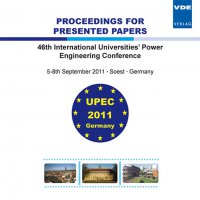Development of an Interactive, Web-based Energy Usage Application for Residential Loads
Conference: UPEC 2011 - 46th International Universities' Power Engineering Conference
09/05/2011 - 09/08/2011 at Soest, Germany
Proceedings: UPEC 2011
Pages: 6Language: englishTyp: PDF
Personal VDE Members are entitled to a 10% discount on this title
Authors:
Preez, K. du; Vermeulen, H. J. (Stellenbosch University, Stellenbosch, South Africa)
Abstract:
The South African energy landscape is dominated by Eskom, the state-owned utility which generates 95% of the electricity used in South Africa. To meet the rising electricity demand, Eskom is now facing a supply and demand scenario where they can no longer afford the cost of consumer passivity and apathy and must leverage the benefits to be reaped from end-user energy efficiency initiatives. Although this paper focuses on the South African context, the pressures facing Eskom are not unique. Any electrical energy system should improve efficiency on both the supply and demand sides. Intervention is required to influence energy use. On the supply-side, interventions typically include the introduction of renewable sources to expand the energy mix and technological improvements to curb energy leaks and losses. On the demandside, interventions include both an improvement of the efficiency of end-use technologies as well as methods to influence the ways we use energy. A consumer's ability to make consumption decisions leads to more judicious electricity use, supporting peak demand management. Smart metering systems which provide real-time display of household energy use, is one such a tool to influence and empower a consumer to improve efficiency. This paper describes the development of a web-based evaluation tool for end-users to improve energy efficiency. It can be incorporated with a smart metering system or used as a stand-alone survey/auditing tool for gathering and evaluating consumption data. Available technologies were evaluated and due consideration given to current trends in improving user experiences on the web. Currently, Rich Internet Applications (RIAs), offer a more seamless data exchange process as well as a richer, more dynamic user interface. The Flex framework is the chosen RIA development platform, which is fully integrated with open-source PHP, as the server-side scripting language, and MySQL as the database. The design favours graphic content and intuitive navigation. Being dynamic, and database-driven, the application is developed with ease of maintenance and extendibility in mind.


